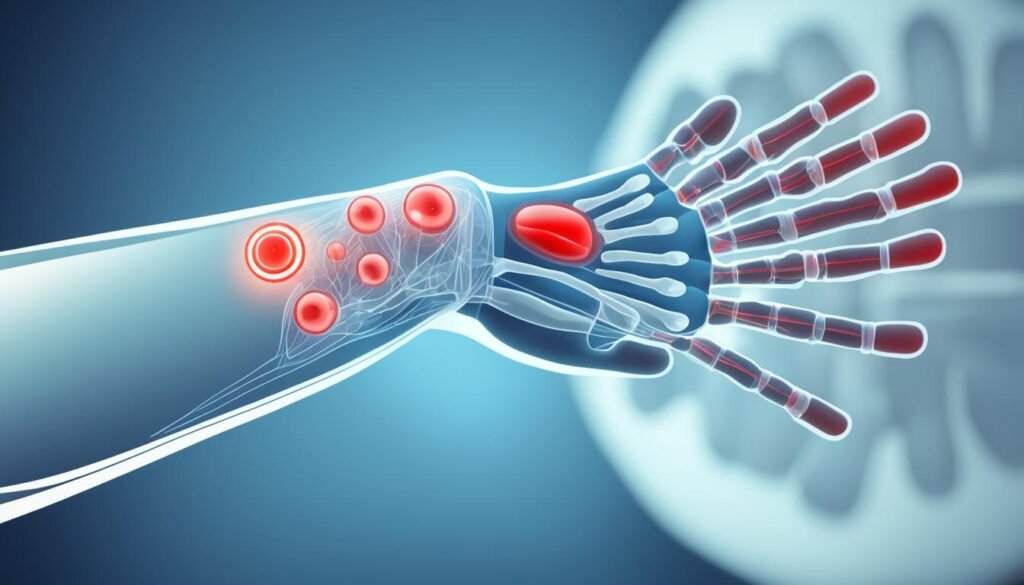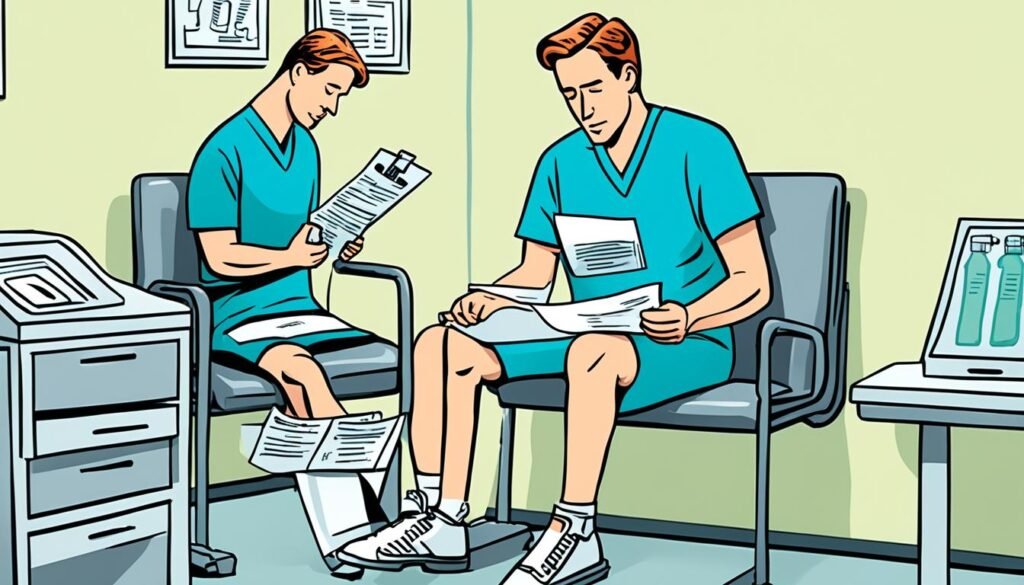These tumors form around your peripheral nerves and can lead to pain, numbness, tingling, and weakness. Luckily, there are ways to treat them effectively. This includes medicines and surgeries. These treatments can reduce your symptoms and better your life.
Getting treated successfully involves a team effort. Experienced doctors like neurologists and neurosurgeons team up with other experts. They tailor a treatment plan just for you. This helps ensure the best results since handling a benign peripheral nerve sheath tumor treatment needs special knowledge and a close look at your unique situation.
Sometimes, for small or slow-growing tumors with minimal symptoms, the best step is just to keep an eye on them. Your doctor will check the tumor regularly with physical exams and scans like MRIs or CTs. If the tumor doesn’t change and you feel okay, this watch-and-wait method may be the way forward for you.
Yet, if the tumor starts growing fast or causes more problems, surgery might be needed. The aim of surgery is to take out the entire peripheral nerve tumor. But the surgeons also want to keep your healthy nerves safe and limit any nerve damage. They use cutting-edge tools to accurately find and remove the tumor.
As you go through your treatment, your healthcare team will make sure they consider what you want and what fits your life best. With their help and by learning about current peripheral nerve tumor treatments, you’ll be able to play an active role in getting better.
Table of Contents
ToggleUnderstanding Benign Peripheral Nerve Sheath Tumors
Peripheral nerve sheath tumors are growths found in nerve sheaths. These sheaths protect and cover your nerve fibers. The two main types of benign tumors are schwannomas and neurofibromas. Schwannomas grow from Schwann cells. These cells make the myelin sheath. Neurofibromas come from the nerve sheath’s connective tissue.
What Are Peripheral Nerve Sheath Tumors?
These tumors can grow on their own or due to genetic conditions like NF1, NF2, and schwannomatosis. What causes them in non-genetic cases isn’t clear. It might be due to genetic changes or things in the environment.
Types of Benign Peripheral Nerve Sheath Tumors
Besides schwannomas and neurofibromas, there are perineuriomas, lipomas, and ganglion cysts. Perineuriomas come from perineurial cells. Lipomas are slow-growing tumors made of fat. Ganglion cysts often form near joints and can be painful.
Causes and Risk Factors
We don’t always know what causes these tumors. Some may run in families. Schwannomas usually start in one nerve, while neurofibromas can come from many nerves. Knowing the types and causes is key to finding the best treatment.
Symptoms and Diagnosis
Peripheral nerve sheath tumors come with different symptoms. These depend on the tumor’s size and location. You might feel pain, numbness, tingling, or weakness. Some patients also see or feel a lump in the area. These symptoms can really affect your daily life.
Common Symptoms of Peripheral Nerve Sheath Tumors
Benign tumors like schwannomas and neurofibromas cause a variety of issues. You could have swelling, pain, tingling, or weakness. These symptoms change with the tumor’s size, place, and type.
Diagnostic Tests for Benign Peripheral Nerve Sheath Tumors
Your doctor might use MRI or CT scans to find the tumor. These tests show where it is. They might also do an Electromyography (EMG) or nerve test to look at nerve function. Sometimes, a biopsy is needed to confirm the tumor type.
Getting an early diagnosis is key. It helps start the right treatment sooner. Working with your healthcare team is crucial. Together, you can make a treatment plan that fits your needs.

Benign Peripheral Nerve Sheath Tumor Treatment
Monitoring and Watchful Waiting
Some patients may benefit from watching benign peripheral nerve sheath tumors closely. This method is great for small, slow-growing tumors that cause minor issues. Doctors suggest having regular check-ups and occasional scans like MRI or CT.
If the tumor doesn’t grow and you don’t get more symptoms, just watching it may be enough. But, if it starts growing fast or you feel sicker, surgery could be needed. Keep an eye on it and act fast if things change.

Surgical Treatment Approaches
Patients with benign peripheral nerve sheath tumors may need surgery if they have severe symptoms or if their tumors are growing quickly. The main goal of this surgery is to fully remove the tumor. It aims to keep the healthy nerve tissue around it safe and lower the risk of nerve damage.
Goals of Surgical Intervention
The focus is on removing benign peripheral nerve sheath tumors like schwannomas. Surgeons use advanced tools to do this. They work very carefully to not harm the healthy nerves near the tumor. This type of surgery is very precise and detailed.
Microsurgical Techniques
High-powered microscopes and nerve stimulators are new tools that make surgery on these tumors easier. These tools help surgeons reach difficult areas more easily. With microsurgery, the goal is to fully remove the tumor without hurting the nearby healthy nerves.
Postoperative Rehabilitation
After surgery, patients may need rehab to get their function and movement back. The outcomes depend on the tumor’s size, where it is, and how much of it was removed. The skill of the surgical team also plays a big part in a patient’s recovery.
Benign Peripheral Nerve Sheath Tumor Treatment
How we treat benign peripheral nerve sheath tumors depends on many things. This includes size, where they are, how fast they grow, your symptoms, and general health. If a tumor is small and doesn’t cause any problems, doctors might just keep an eye on it. But, if it’s big, gives you trouble, or grows quickly, it might need to be removed with surgery.
Doctors will try to take out the whole tumor while not hurting the good nerve around it. They also want to lower the chance of nerve damage. For some hard-to-reach tumors, doctors may use a treatment called stereotactic radiosurgery. This treatment sends strong radiation beams right at the tumor. It’s a planned approach where a team of doctors, like neurologists and neurosurgeons, will decide the best treatment for you.
The [benign peripheral nerve sheath tumor treatment options] you have depend on your tumor, health, and what you prefer. Your medical team will help figure out the best way to treat your tumor. They’ll work with you to get the best result possible.
Stereotactic Radiosurgery for Benign Peripheral Nerve Sheath Tumors
Stereotactic radiosurgery is a method used for some benign peripheral nerve sheath tumors. These tumors are hard to reach through surgery or risk nerve damage. It uses focused radiation beams to treat the tumor directly, avoiding open surgery. This is especially helpful for tumors near the brain or spinal cord.
This treatment has its risks, like nerve weakness or numbness in the treated area. However, for some patients, it’s a good option if regular surgery is risky or not possible. Stereotactic radiosurgery is a great alternative to open surgery for benign peripheral nerve sheath tumors, including Schwannomas, in certain cases.
Multidisciplinary Approach to Treatment
Benign peripheral nerve sheath tumors are best treated by a team of experts from different fields. This group includes neurologists, neurosurgeons, radiologists, and rehab specialists. Having a team with varied skills is key because these tumors are rare, and treatment can be complex. Thus, working together helps create the best treatment plans for patients.
Importance of Experienced Care Teams
Teams with experience in treating peripheral nerve tumors offer better patient care. They know how to diagnose, treat, and help patients recover from these tumors. Their experience leads to better outcomes for those affected by benign peripheral nerve sheath tumors.
Coordinated Care for Best Outcomes
For the best results, all healthcare providers must work together. Communication and collaboration are key. This approach helps in every step of the patient’s care journey, making sure they receive the best treatment and support. It aims to improve both their health and quality of life.

Coping and Support Resources
Dealing with a benign peripheral nerve sheath tumor can be tough for you and your loved ones. It’s not just about the physical symptoms or treatment. The emotional and psychological toll can be significant. Seeking support like counseling or joining a support group can help a lot.
Emotional and Psychological Support
Getting a diagnosis and treatment plan for a peripheral nerve sheath tumor can be mentally and emotionally draining. A counselor or therapist who understands rare medical conditions can be a big help. They can teach you coping strategies and help manage stress and anxiety.
Patient Support Groups
Connecting with those who understand your struggles is key. Your doctors might know about local or online groups for those with similar issues. These groups are great for sharing experiences, gaining insights, and finding coping tips.
Always remember, you’re not battling this alone. Talking to people who get what you’re going through and getting professional support can improve your well-being. It helps in dealing with the problems a peripheral nerve sheath tumor brings forward.

Preparing for Your Appointment
If you or someone you know has a benign peripheral nerve sheath tumor, getting ready for your doctor’s visit is key. You might see a special doctor, like a neurologist or a neurosurgeon. They know how to treat these tumors.
What to Expect During Your Consultation
At your appointment, the doctor will go over your medical history and check you. They might also order tests like imaging studies or nerve conduction tests. Make sure to bring any past medical records or test results.
Questions to Ask Your Healthcare Provider
It’s smart to have questions ready. Ask about the tumor’s type and stage, your treatment options, and what risks there are. Also, learn what to expect during and after any treatments. Talking openly with your healthcare team will help you make good choices about your health.

Postoperative Care and Follow-Up
After surgery for a benign peripheral nerve sheath tumor, keeping up with postoperative care is key. Your doctors will watch you carefully for any signs of the tumor coming back. They will use regular exams and imaging tests. If the tumor does come back, more treatment like another surgery or radiation might be needed.
Monitoring for Recurrence
Going to follow-up appointments and having regular scans, like MRI or CT scans, is important. This way, your healthcare team can catch any signs of the tumor early. Doing this helps ensure you get help quickly, which is good for your recovery.
Rehabilitation and Physical Therapy
Rehabilitation and physical therapy are vital for your recovery. You might work with physical and occupational therapists to get back your strength and ability to move. This team effort in your care aims to get the best results and decrease any lasting problems.
Emerging Treatments and Future Directions
The treatment of benign peripheral nerve sheath tumors is getting better all the time. This is thanks to new ways of doing surgery and understanding these tumors better. Surgical techniques now include better imaging and checking the tumor as it’s removed. This helps make surgery more accurate and safer.
What’s more, people are excited about using certain drugs and treatments that boost the body’s immune system. These could be very effective against these tumors.
Research on Novel Therapeutic Approaches
Many studies are looking at how well and safely these treatments work on peripheral nerve sheath tumors. As these studies progress, new treatment options are becoming available. This gives patients and their doctors the chance to use the latest and greatest care.
Ongoing Clinical Trials
Staying up-to-date about the progress in treating these tumors is key. With the support of doctors and the latest information, patients can face their situation with hope.
Conclusion
Benign peripheral nerve sheath tumors are a complex issue. They need many experts to work together for treatment. Some can just keep an eye on their tumors and wait. Others might need surgery or advanced treatments. But, with skilled healthcare teams and new treatments, these patients can often do well.
It is crucial to keep up with the latest in this area and work closely with doctors. This way, patients can feel sure and have a good chance of getting better. The insights from the LSU Health Sciences Center’s study on these tumors for 30 years show us a lot about how to treat them well.
Research keeps making things better for those with benign peripheral nerve sheath tumors. Patients and their healthcare teams should be hopeful about the future. Taking a team approach and keeping up with new ways can help patients be in control of their health. This way, they can get the best results.
FAQ
What are benign peripheral nerve sheath tumors?
Benign peripheral nerve sheath tumors are growths around peripheral nerves. They may lead to pain, numbness, and weakness.
What are the common types of benign peripheral nerve sheath tumors?
Schwannomas and neurofibromas are common in this group. Schwannomas start from Schwann cells, neurofibromas from nerve sheath connective tissue.
What are the possible causes and risk factors for benign peripheral nerve sheath tumors?
They may appear randomly or with genetic disorders like NF1, NF2, and schwannomatosis. How they form is still unclear, but genes and environment might be factors.
What are the common symptoms of peripheral nerve sheath tumors?
Symptoms include pain, tingling, weakness, and sometimes a noticeable mass. They can also cause burning and numbness.
How are benign peripheral nerve sheath tumors diagnosed?
Doctors use MRI or CT scans to see the tumor and its position. They might also do an EMG or nerve conduction study. Sometimes, a biopsy is needed for a full diagnosis.
When is a medical management approach appropriate for benign peripheral nerve sheath tumors?
This approach fits for small, slow-growing tumors with minor symptoms. It involves checking the tumor’s progress regularly without immediate surgery.
What are the goals of surgical treatment for benign peripheral nerve sheath tumors?
The aim is complete tumor removal, keeping the nerve healthy. Surgeons use advanced tools to accurately cut and remove the tumor.
What is the role of stereotactic radiosurgery in the treatment of benign peripheral nerve sheath tumors?
It’s an option for tumors hard to reach or if surgery risks damaging the nerve. The method directs radiation precisely at the tumor.
Why is a multidisciplinary approach important for the treatment of benign peripheral nerve sheath tumors?
A team with different specialties ensures a well-rounded treatment plan. This teamwork is key to successful treatment.
What kind of emotional and psychological support is available for patients with benign peripheral nerve sheath tumors?
Counseling and support groups are great for patients. They offer emotional help and connect people facing similar challenges.
What should patients expect during their consultation for a benign peripheral nerve sheath tumor?
They will get asked about their health and undergo tests. Patients should bring their medical history and any questions they have.
What is involved in the postoperative care and follow-up for patients with benign peripheral nerve sheath tumors?
After surgery, the patient will be checked for tumor return frequently. Physical therapy and rehab are significant for recovery.
What are some of the emerging treatments and future directions in the field of benign peripheral nerve sheath tumor management?
New surgical methods and drug therapies are under study. Clinical trials are working to find effective and safe treatments for these tumors.
Source Links
- https://www.ncbi.nlm.nih.gov/pmc/articles/PMC10439084/
- https://www.mayoclinic.org/diseases-conditions/peripheral-nerve-tumors/diagnosis-treatment/drc-20355075
- https://www.hopkinsmedicine.org/health/conditions-and-diseases/nerve-sheath-tumor
- https://www.mayoclinic.org/diseases-conditions/peripheral-nerve-tumors-benign/symptoms-causes/syc-20368680
- https://my.clevelandclinic.org/health/diseases/22526-nerve-sheath-tumors
- https://www.ncbi.nlm.nih.gov/pmc/articles/PMC6687493/
- https://www.ncbi.nlm.nih.gov/pmc/articles/PMC8587702/
- https://www.ncbi.nlm.nih.gov/pmc/articles/PMC6774487/
- https://www.ncbi.nlm.nih.gov/pmc/articles/PMC10296369/
- https://www.mayoclinic.org/diseases-conditions/peripheral-nerve-tumors/care-at-mayo-clinic/mac-20355078
- https://www.mayoclinic.org/diseases-conditions/malignant-peripheral-nerve-sheath-tumors/diagnosis-treatment/drc-20362619
- https://www.ncbi.nlm.nih.gov/pmc/articles/PMC7957633/
About The Author

This article is medically reviewed by Dr. Chandril Chugh, Board-Certified Neurologist, providing expert insights and reliable health information.
Dr. Chandril Chugh is a U.S.-trained neurologist with over a decade of experience. Known for his compassionate care, he specializes in treating neurological conditions such as migraines, epilepsy, and Parkinson’s disease. Dr. Chugh is highly regarded for his patient-centered approach and dedication to providing personalized care.
→ Book a consultation to discover which remedies suit your needs best.




